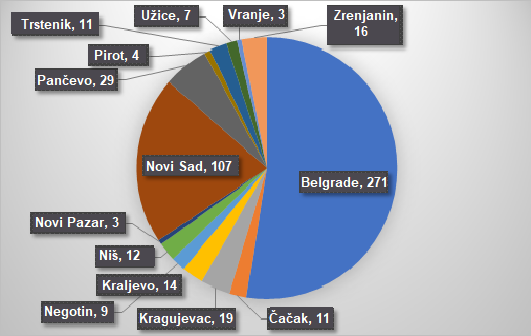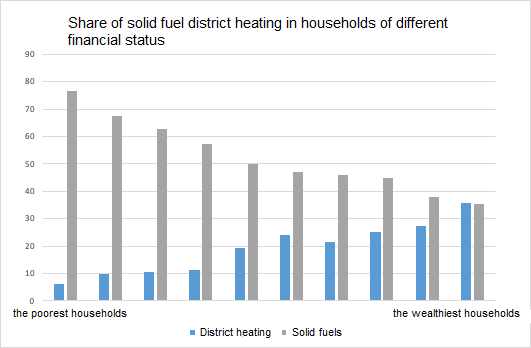The Ministry of Mining and Energy implements the Public ESCO project entitled “Energy renovation of residential, multi-family buildings connected to the district heating system”. The project is financed by a grant and loan from the European Bank for Reconstruction and Development in the amount of 64.5 million euros (14.5 million as a grant and 50 million as a loan). The goal of the Public ESCO project is to finance energy efficiency measures at these facilities. The measures include the installation of insulation on the building and the transition of households to billing according to heat energy consumption. It is planned that 50% of the investment will be non-refundable, while the remaining 50% of the value of the investment will be repaid by the household through the heating bill. The Government of the Republic of Serbia expects that the project, in addition to improving energy efficiency, will produce other benefits:
- extending the life of buildings,
- increasing the comfort conditions of the users of facilities and tenants,
- financing the project from the achieved savings,
- a significant increase in the value of real estate that is the subject of rehabilitation, without personal credit indebtedness of the users themselves,
- the possibility of influencing one’s own consumption of heat energy for heating and reducing heating bills as well as costs for cooling the space in the summer period,
- rehabilitation of dilapidated facades and roofs and reduction of the risk of injury to tenants and passers-by in case of unforeseen events,
- reduction of maintenance costs.[1]
Understanding the structure of district heating in Serbia and the way in which this service is performed, we can say with certainty that taxpayers will help the business of the natural gas supply sector.
…in Belgrade and Novi Sad
At this moment, 14 local self-governments have conducted public calls for the application of housing communities to participate in the project.[2] Based on RES Foundation’s research and calculations, 516 residential communities were selected, which represents 0.94% of all registered residential communities in Serbia. In Belgrade, 1.03% will be rehabilitated, and in Novi Sad, around 1.85% of all residential communities registered in these two cities. The largest share of selected residential communities in the total number is in Negotin and Trstenik (6% and 4.3%).
Of the 516 selected housing communities, 52% are located in Belgrade, 20.7% in Novi Sad. Pančevo follows with 5.6% of selected residential communities, while the other 11 cities participate with less than 4% individually (Chart 1). Of all households connected to district heating in Serbia, 63% are located in Belgrade and Novi Sad (Belgrade 50%, Novi Sad 13%).[3]

Remote goal achievement
The area of apartments in 96 selected housing communities in New Belgrade and Vračar amounts to over 330,000 square meters[5]. According to the data of the Republic Geodetic Institute on the average prices of traded real estate in these municipalities in 2023, the market value of these apartments in selected residential communities in New Belgrade and Vračar is almost 850 million euros.[6] It seems that this project will really achieve the goal: “a significant increase in the value of real estate that is the subject of rehabilitation, without personal credit indebtedness of the users themselves“.
Bearing in mind the distribution of the type of heating in relation to the property status of the population in the Republic of Serbia (Chart 2), RES Foundation asks whether and in what process the Republic of Serbia correctly decided to allocate public money as a priority to these citizens in multi-family buildings connected to the system of district heating …”without personal credit liability of the users themselves“. We invite readers to ask the same or another question to the decision makers.

[1] https://www.mre.gov.rs/tekst/2437/projekat-energetska-sanacija-stambenih-vise-porodicnih-zgrada-prikljucenih-na-sistem-daljinskog-grejanja-javni-esco-projekat-.php
[2] https://www.mre.gov.rs/extfile/sr/2443/Public%20ESCO%20-%20linkovi%20rang%20liste%2027.5.24.xlsx
[3] https://data.stat.gov.rs/Home/Result/31020307?languageCode=sr-Latn
[4] https://www.mre.gov.rs/extfile/sr/2443/Public%20ESCO%20-%20linkovi%20rang%20liste%2027.5.24.xlsx
[5] Assessment of Res Foundation based on a search of data from the cadastre for addresses published on https://shorturl.at/Elx7j
[6] https://www.rgz.gov.rs/content/docs/000/000/006/ГОДИШЊИ_ИЗВЕШТАЈ-ЗА_МЕДИЈЕ_2023.pdf
[7] https://publikacije.stat.gov.rs/G2023/Pdf/G20235699.pdf
